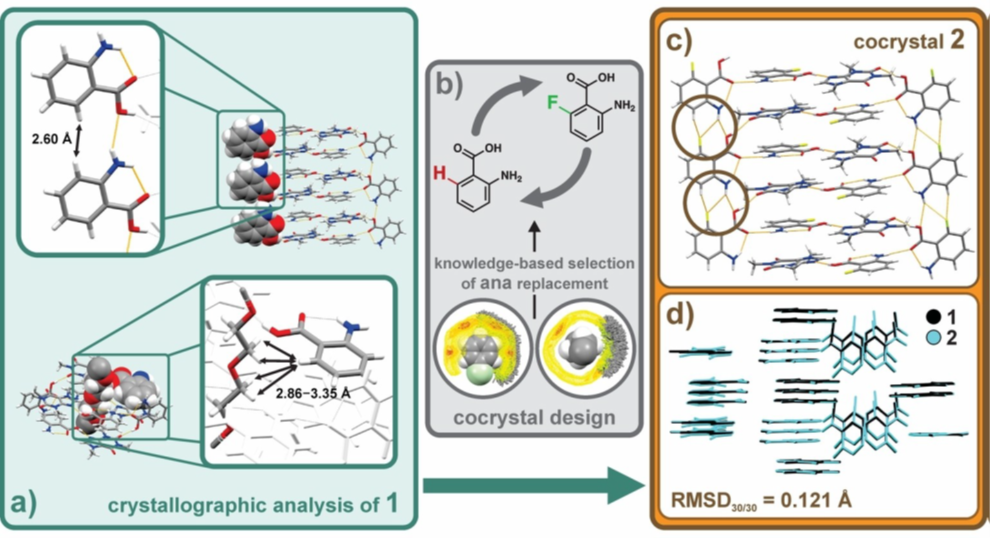CSD in Action: Knowledge-based Cocrystal Design
Here we highlight the use of a knowledge-based approach that accessed the curated structural data in the Cambridge Structural Database (CSD) and its library of intermolecular interactions to design a new isostructural cocrystal of a polymer.
Read the full article and find out more about the CCDC data, software, and services to advance structural science that were used in this work.
Why?
The design of solids with specific properties can be challenging. In the past decades, research has focussed solely on crystal engineering of small molecules (e.g. pharmaceuticals, energetic and electronic materials), including their use as organic linkers for the synthesis of porous materials.
In this work published in Angewandte Chemie, the team of Dejan-Krešimir Bučar and Dritan Hasa reported a study where the scope of crystal engineering is expanded from small molecules to polymers. The knowledge-based approach that the scientists used allowed them to enhance the physicochemical properties of polyethylene glycol (PEG), a polymer with various applications in medicine and biology, using cocrystallization and other crystal engineering strategies.
How?
The team compared the properties of the polymer poly(ethylene glycol) dimethyl ether (PEG-DME) with the ones of the cocrystal of PEG-DME with caffeine (caf) and anthranilic acid (ana), named 1. They observed that cocrystallization boosted the thermal stability of the polymer considerably, with an increase of melting point from 36 °C in PEG-DME to 98 °C in 1, while maintaining the mechanical flexibility of the polymer.
A crystallographic analysis of 1 attributed the increased thermal stability to the incorporation of the polymer into a molecular scaffold formed from caf and ana, stabilized by strong hydrogen bonds. A deeper inspection of the crystal structure of 1 showed an unsubstituted ortho position of the ana molecules, with the hydrogen atoms at a distance of 2.60 Å (Figure 1a). These observations were key for the next steps of the crystal engineering process.

Angew. Chem. Int. Ed. 2023, 62, e202212688.
Considering the position in the ana molecules that was not involved in any intermolecular contact, alongside the distance between the aforementioned CH moieties, the scientists theorized that the ortho-positioned hydrogen atom in ana could be replaced with a fluorine atom (Figure 1b) without disrupting the crystal structure.
To validate this theory, the team performed a survey of the CSD using the IsoStar library of intermolecular interactions, and assessed whether the fluoro-substitution would have been sterically disruptive for the crystal packing. The investigation not only led to positive results confirming that the substitution would have been successful, but also highlighted the potential for further stabilizing interactions (attractive C-F···H) to emerge.
As the last step of the crystal design strategy, the scientists succeeded in synthesizing the cocrystal comprised of PEG-DME, caf and 6-fluoro-anthranilic acid (6Fana, the fluoro-substituted molecule) reported in Figure 1c. This cocrystal, named 2, is isostructural to 1, as it can be seen by their matching molecular positions obtained from the crystal-packing similarity analysis performed with Mercury (Figure 1d). Finally, it was seen that the replacement of ana with 6Fana further enhanced the melting point of the polymer which went from 98 °C in cocrystal 1 to 128 °C in cocrystal 2.
The Tools
IsoStar is a knowledge-based library of intermolecular interactions that can help understanding how crystal structures pack in the solid state. The team used this tool to identify molecules suitable for substitutions of the caf and ana components in cocrystal 1, and recognized fluoro-derivatives as the most promising candidates.
The Crystal Packing Similarity tool is a component of the CSD-Materials suite that helps identifying and quantifying the similarity between polymorphs, solvates, salts, hydrates and cocrystals. The researchers performed a crystal packing analysis to assess the isostructurality of the two polymer cocrystals.
Next Steps
Find out more in this video that explains how to navigate IsoStar using the online server.
Learn how to conduct a crystal packing similarity search with Mercury.
Don’t miss the last data updates on Crystal Packing Similarity Enhancements for Crystal Structure Prediction, and find out more in these CSD-Materials self-guided workshops.
To discuss further and/or request a demo with one of our scientists, please contact us via this form or .